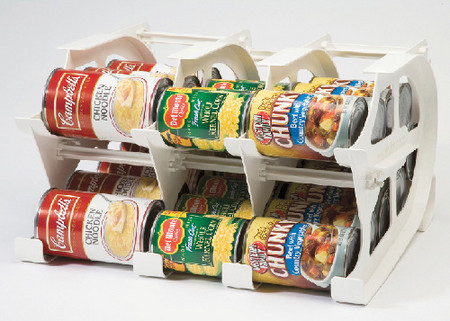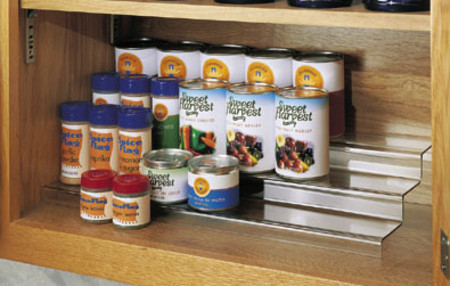Kitchen activities dictate how to organize cabinets
DEAR DESIGNER: My kitchen is small and I can't afford to put in a new one right now. Are there any standard guidelines for arranging my kitchen cabinets so I can make the most of them? -- Sylvia
DEAR SYLVIA: Organization is the key to getting the most out of your cabinet space. When purchasing a new kitchen you'll find many built-in cabinet organizers that help you streamline your kitchen. When working with existing cabinets, indeed there are some guidelines as well as some gadgets that can help.
Although many of these tips may seem elementary and obvious to some, I have discovered organization does not come naturally to everyone.
Divide your kitchen into the various work stations: preparation, cooking, baking, clean-up, storage and dinnerware.
Arrange the items in your cabinets by considering how you use the various spaces. For example, in the cooking station put spices within arm's reach of the cooktop, but not so close that the heat will damage their quality. Put cooking utensils in a drawer close to the cooktop so they can be accessed easily while cooking. For clean-up store cleaning supplies under the sink.
If you have a preparation station, like an island, put mixing bowls in those cabinets. Measuring cups and stirring spoons along with knives will come in handy when stored in the drawers of your island. Don't forget to also store your cutting boards in a drawer near your prep station.
Glasses and dinnerware are traditionally stored in an upper cabinet. Be sure the most breakable glassware is stored on the bottom most shelf. Plastic cups that won't break when fumbled during a stretching reach can be stored higher. Some say to put glasses and dishes near the dishwasher so they are easy to put away when they are clean.
This will save you steps. However, these are only suggestions and you must think through how you personally use your kitchen to know the best possible place for yours. I put my dishes and glasses in a cabinet at the end of the counter. They are far enough away from my prep station that I can recruit help setting the table without tripping over my helper.
In the past, glasses were almost always kept near the sink so it would be easy to get a drink of water. This is still a good idea if you use a water purifier on your sink. Many water filtration systems today are in the refrigerator so now it makes better sense to store your glasses close to that location. It's also handy for getting ice and pouring a glass of iced tea or lemonade on a hot Las Vegas day.
If you keep a coffee maker on your counter, it's convenient to store coffee cups, sugar, dry creamers and filters in a cabinet right above.
Traditionally, a pantry is the place to store nonperishable foods. But don't be locked in to only one use. Walk-in pantries usually have deep shelves perfect for storing small appliances like mixers, crock pots and juicers.
After you've defined where your various work stations are, you will need to figure out how to organize the individual items on the shelves.
Even a cabinet that is designated for "canned goods" can get cluttered and hard to use. There are stores and Web sites that sell nifty dividers and organizers like the items pictured. It's amazing how helpful these items can be. They not only help you stay organized, they save valuable space in a small kitchen.
If you keep your spices in a cabinet instead of displayed on a counter, be sure they are arranged so you can see them. A tiered spice rack or cabinet lazy Susan works great.
Nest (stack) your storage containers. Many times these will need a cabinet all their own. By putting the lids into a nearby drawer, you can keep your storage containers neat and easy to access. Put pans near the stove or under the cooktop. Since pans are usually stacked in order to fit them into the cabinet, put the lids on the shelf above the pans. Even better, purchase a pull-out lid organizer like the one shown here from www.organizeworld.com.
Keep the pans you use most near the front of the cabinet so they are easy to access. Store baking pans and casserole dishes near the oven.
The most organized sink cabinets I've seen are those where the usual cleaning supplies are stored inside of removable totes. Simply pull out the totes during cleaning days. And should you ever have plumbing problems, it's easy to clear the way for your plumber.
Dish towels should be kept in a drawer near the sink. Pot holders need to be near the oven. Place mats and cloth napkins can go in a furthermost drawer, near the table.
Deep, dark corner cabinets and cabinets above the refrigerator can be difficult to reach. These are the places you will store your least-used items. If you make cookies once a year, store your cookie press in the back cabinet. If you serve a large crowd once a year, put some of your least-used serving dishes and your seasonal dishes in these hard-to-reach areas.
And finally, it's important to know that however you originally set up your kitchen you can continue to fine- tune it for better storage and optimal performance.
An organized kitchen makes cooking enjoyable, a safer environment for your family and a lovely place to entertain guests.
For more tips, visit these space-saving Web sites: www.organizeit.com, www.organizeworld.com, www.Containerstore.com and www.spacesavers.com.
Cindy Payne is a certified interior designer with more than 25 years of experience, a member of the American Society of Interior Designers, as well as a licensed contractor. E-mail questions to her at deardesigner@projectdesign interiors.com or send them to her at Project Design Interiors, 2620 S. Maryland Parkway, Suite 189, Las Vegas, NV 89109. She can be reached online at www.project designinteriors.com.
























